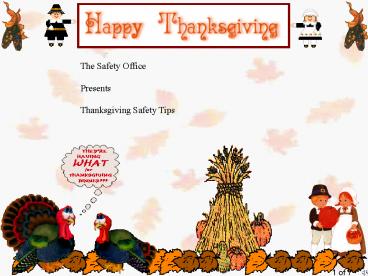Thanksgiving PowerPoint PPT Presentation
1 / 7
Title: Thanksgiving
1
The Safety Office Presents Thanksgiving Safety
Tips
1 of 7
2
Holiday Cooking
Avoid loose-fitting clothing. Never leave the
kitchen unattended when cooking. Always turn pot
handles inward. Don't store items on the stove
top - they could catch fire. Keep kitchen
appliances clean and in good condition -- turn
off after use. Don't overload electrical outlets
or use electrical appliances near water. Be sure
the kitchen is well ventilated to prevent the
build-up of carbon monoxide from gas cooking
appliances. Equip the kitchen area with smoke
detectors and a all purpose fire extinguisher.
2 of 7
3
Turkey Safety Tips
Cool it Place turkey in the refrigerator or
freezer immediately. Do not refreeze poultry that
has previously been frozen.
- Thaw it
- Never thaw frozen turkey at room temperature.
Leave turkey in original package and follow
either of the these methods - Refrigerator Method Place turkey on a tray in
your refrigerator. Allow five(5) hours per pound
or 10 hours per kilogram for thawing process. - Cold water Method In a large container cover
turkey completely with cold water. Change water
every hour. Allow one hour per pound for thawing
process. - Note If you have purchased a frozen, pre-stuffed
turkey, DO NOT THAW! Cook from frozen state and
check product label for further instructions.
Clean it Remove neck and giblets from body
cavity. Rinse inside and out with cold water.
Thoroughly pat dry with paper towels. Always wash
hands thoroughly in hot soapy water before
handling raw meats and preparing foods.
Cook it The center of meat should not be pink
and the juices should run clear.When baking, set
oven no lower than 325o F or 160o C.After
cooking, refrigerate leftovers. Separate into
small portions for fast cooking. To reheat all
leftovers, cover and heat until hot and steaming
throughout.
Store it Fresh when storing fresh turkey,
remove giblets and refrigerate in a covered
container for use within two days. Frozen whole
turkeys can be kept frozen for one year, parts
for six months. Once the bird is thawed, treat as
a fresh turkey and do not refreeze until cooked.
Cooked Cooked turkey products may be stored in
a covered container, plastic bag or aluminum foil
for up to four days in the refrigerator, or up to
three months in the freezer.
3 of 7
4
Home Family Safety
Use lighting liberally on the interior and
exterior of your home. Consider installing
outdoor motion-sensitive lights. Use lighting
timers when away from home in the evening..
Prune shrubs away from windows and doors. Remove
tree limbs that could allow a thief access to a
second-story window. Never hide house keys in a
mailbox, planter or under a mat. When leaving
home for a few days, have deliveries of papers,
mail etc. suspended or ask a reliable neighbor to
collect them while you are away. Avoid leaving
messages on your phone answering machine that
lets callers know you will be away from home.
When moving into a home or apartment, have all
exterior locks re-keyed. Regularly inspect all
door and window locks for wear. Lock sets fitted
with dead latches (small brass elements that ride
on the face of the latch) prevent jimmying with
plastic strips or credit cards. Entry doors
should have extra-security dead bolts with full
1-inch bolts, preferably all-steel and brass
construction with a cylinder guard. Remember this
includes the back door, garage door and the patio
door. Consider buying the same brand of dead bolt
in order to have them all keyed alike. For doors
with glass panels within three feet of the lock,
use a double-cylinder dead bolt. These require
key operation from both sides.
4 of 7
5
General Rules for Holiday Safety
Keep matches, lighters, and candles out of the
reach of children. Avoid smoking near flammable
decorations. Make an emergency plan to use if a
fire breaks out anywhere in the home. See that
each family member knows what to do. PRACTICE
THE PLAN! Avoid wearing loose fitting clothes,
particularly long, open sleeves, near open
flames-such as those of a fireplace, stove, or
candlelit table. Never burn candles near
evergreens. Burning evergreens in the fireplace
can also be hazardous. When dry, evergreens burn
like tinder. Flames can flare out of control and
send sparks flying into a room or up the chimney
to ignite creosote deposits. Plan for safety.
Remember, there is no substitute for common
sense. Look for and eliminate potential danger
spots near candles, fireplaces, trees, and/or
electrical connections. Be familiar with the
operation of each type of fire extinguisher in
the home. Purchase fire extinguishers that are
designed to put out the types of fires most
likely to occur in the areas where they are
located. Extinguishers are rated for specific
classes of fires such as grease or electrical.
5 of 7
6
Personal and Travel Safety
Cause Factors of POV Accidents Driving after
Drinking Driving while Fatigued Excessive
Speed Failure to Wear Seat Belts
Prepare Your Vehicle Winterize Your Vehicle Carry
a Survival Kit in Your Vehicle Attend the POV
Winter Driving Class
Prepare Yourself Dress Properly and never become
overconfident in your ability to deal with the
dangers of the cold temperatures While Walking or
Jogging stay as far off the roadway as possible,
wear bright colored clothes, wear a reflective
belt/vest, and carry a flashlight or chemical
stick
REMEMBER, ACCIDENTS TAKE NO HOLIDAYS OR TIME
OFF SAFETY FIRST
6 of 7
7
The Safety Office Wishes You Your Family A
Safety Happy Thanksgiving
(The End) To print - go to PowerPoint
7 of 7

